Fighting Spruce Bark Beetles in Lubāna Forest District
After prolonged rainfall in 2017, in autumn of last year foresters of JSC “Latvia's State Forests” (LVM) found intensive drying of forest stands in LVM Lubāna Forest District, LVM Ziemeļlatgale Region. The initial reason for the drying was excessive and prolonged water levels in the forest. The weakened spruce stands became the target of spruce bark beetle attack - it is a dangerous forest spruce pest.
“The spruce bark beetle is the most aggressive spruce pest that primarily attacks weakened spruce trees, but can also infect fully healthy spruce trees. At the moment, Lubāna Forest District has been surveyed and the opinion of the State Forest Service has been received. It states that 188 hectares of damaged trees should be removed seamlessly, while in an area of 1078 hectares selective felling should be carried out,” says Dainis Rudzīts, JSC “Latvia's State Forests” Head of Forest Management Planning.
In order not to pose a threat to the valuable spruce stands, the development of seamless renewal felling and thinning works have been terminated in the areas where the proportion of coniferous trees is more than 30%; sanitary thinning has also been discontinued in Lubāna Forest District. This is done with the intention of not creating a scent of cutting residues that attracts spruce bark beetles even more, and to repel them from the stumps of cut trees and reproduction there.
In order to limit the further spread of hazardous fir pests, an action plan has been developed with recommendations, in which order and when the damaged stands should be cut and how pheromone traps should be placed. Currently, mainly felling areas of the damaged trees are being developed based on the State Forest Service's sanitary opinion. Pheromone traps are also deployed in these areas in order to catch flying bark beetles.
Since the end of April 2019, felling of damaged trees has been carried out according to the State Forest Service's sanitary opinion in an area of 88 hectares and 160 pheromone traps have been placed in clearings. 21 liters or 840 thousand bark beetles have been collected within a month since the deployment of traps.




